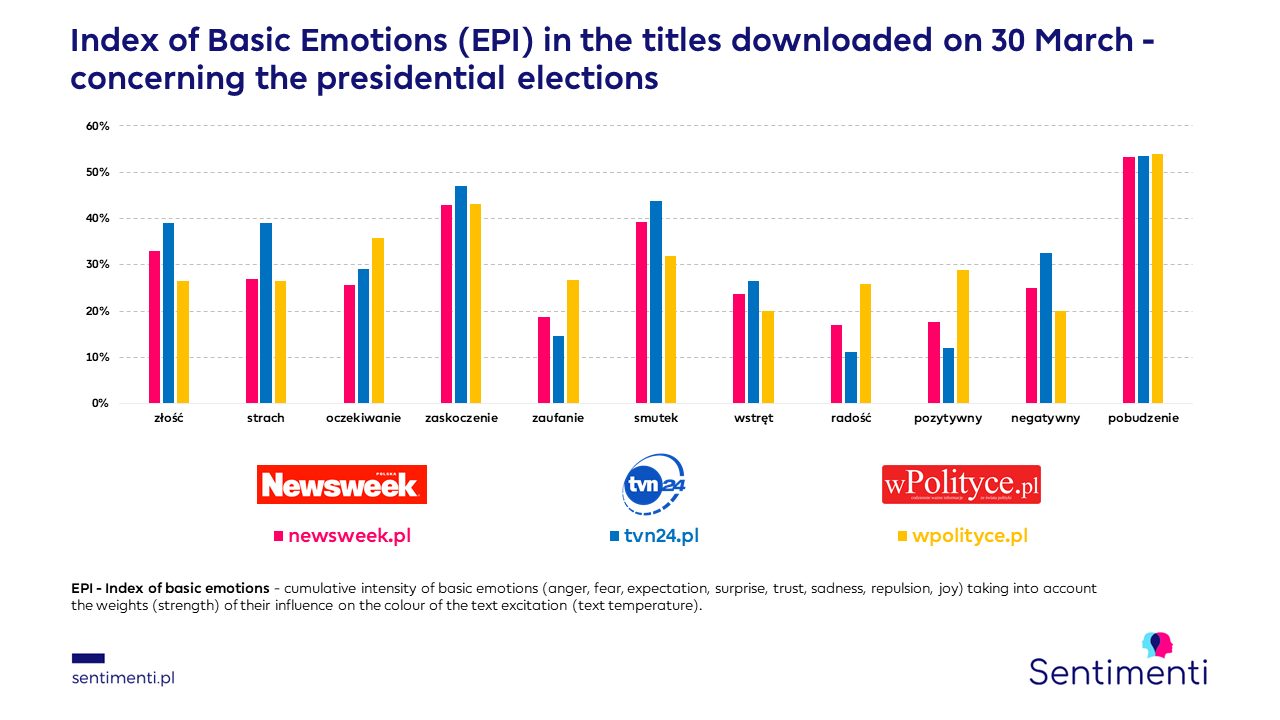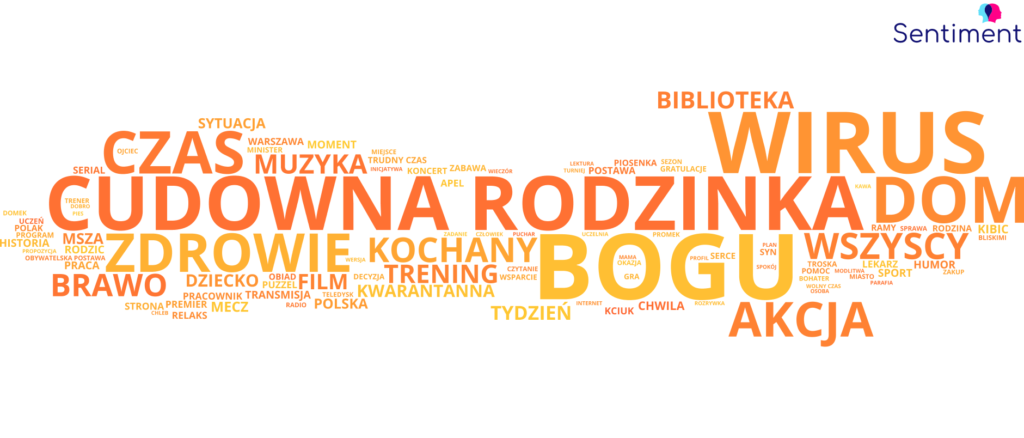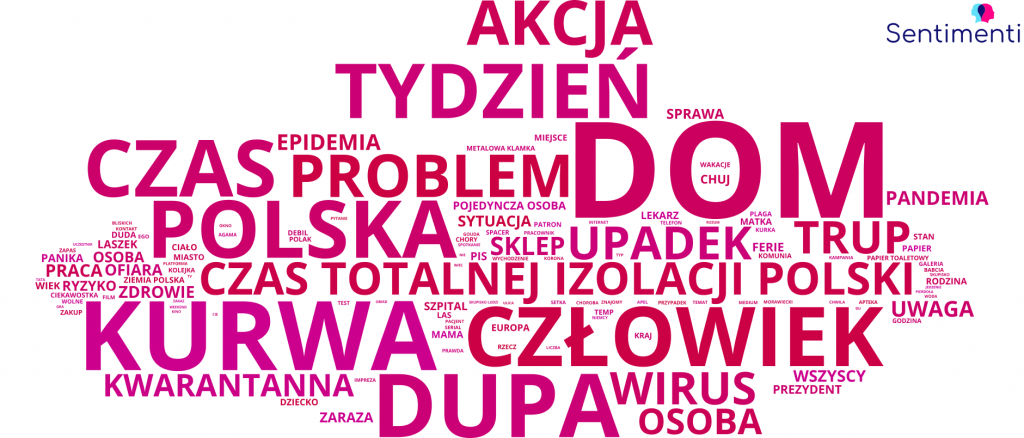
by Sentimenti Team | Apr 1, 2020 | Lifestyle, Politics and Social
We all know that information websites differ in their political, social and even economic preferences. We know that they have the same arsenal of emotions to arouse the interest of readers. But do they use it the same way? We have researched three selected portals: newsweek.pl, tvn24.pl and wpolitce.pl and we analyzed what emotions they used when writing about the presidential elections on March 30. Finally We emphasize – the content of the articles and their conclusions were not analysed, but the emotions used were examined.
Information websites – EPI analysis
Already at the stage of determining the basic emotion index (EPI). There were noticeable differences in the level of colour of arousal created by the titles of the articles.

The general conclusion is that the portals surveyed wrote about the elections with a negative EPI. But the strength of this coloration was significantly different. As the graph above shows, the topic of the presidential elections with the strongest negative colouring was described by the tvn24.pl portal. In emotions similar to the neutral ones, this topic was raised by the portal wpolitce.pl.
Analysis of emotions
The analysis showed the reasons for the differences in the colour strength of the stimulus as depicted by the EPI.

Newsweek.pl and tvn24.pl wrote about the presidential elections, based mainly on negative emotions. The intensity of anger, fear and sadness was definitely higher than trust and joy. This state of affairs caused the agitation (the temperature of the text) to have a strong negative color. And this was probably the way it affected the readers. The wpolitce.pl portal went another way. It used basic emotions balanced in terms of intensity to present its arguments. This procedure resulted in achieving an emotionally close to neutral arousal.
The question as to which of the chosen strategies for gaining readers’ attention was more effective can probably be answered in the number of page views recorded on 30 March on a given portal.

by Sentimenti Team | Mar 22, 2020 | Politics and Social, SentiBrand
In February, we conducted a survey covering 13 news portals grouped into three categories:
- general information portals (wp, interia, onet, gazeta.pl, wpolitce.pl),
- television news portals (tvn24, polsatnews, tvpinfo),
- press information portals (se.pl, fakt.pl, wyborcza.pl, polityka.pl, newsweek.pl).
Arousal and emotions. The subject of the research were the titles of articles published on the main pages of selected portals. The analysis was conducted in terms of emotions and excitement evoked by these titles.
Arousal and emotions
AUDIATION

The stimulus in February was at a comparable level for all categories. The stimulus is the “temperature” of the text’s message received by readers. It was important to analyze the composition of the emotions that the stimulus caused.
EMOTIONS

The graph above shows One thing. All categories of portals used the same main emotions as a “raw material” to build arousal. These were anger, fear, sadness, trust and joy. The differences were only on the level of intensity of used emotions.
INDEX OF BASIC EMOTIONS
However, a mere comparison of the intensity of emotions in absolute terms (in %) does not yet give an answer as to what kind of arousal we were dealing with in the published titles.
The answer can be found in the Basic Excitement Index (EPI) used in the analysis. This index is based on the cumulative intensities of basic emotions (anger, fear, expectation, surprise, trust, sadness, repulsion, joy) with the simultaneous application of weights (force) of their influence on the arousal (text temperature).

In creating the titles, press information portals used emotions generally understood as negative (fear, anger, sadness) to the greatest extent. Such actions resulted in a clear negative colouring of the arousal, which is indicated by the value of the basic emotion index (EPI negative).
Other emotions were used by general information portals. The use of positive emotions (mainly trust and joy) by these publishers resulted in the achievement of a stimulus with a positive colouring. This is indicated by the positive value of the EPI index.
Which strategy of arousing readers’ interest brought better results? The answer can be found only by conducting a broader comparative analysis (primarily over time). The analysis will use additional data about the number of page views, number of internet users, average time per user.
Detailed data on individual portals can be found in the Pilot Report (February 2020) – “Analysis of emotions on information websites”.
Leave us your e-mail. It will be used only to inform you about the news in our emotion monitoring service on portals) and download a free report.


by Sentimenti Team | Mar 18, 2020 | Politics and Social
During the second and third week of March, most of us, if possible, work from home or do “coronaffairs”. The Internet immediately gave birth to appropriate actions and hashtags, above all #stay home. We analyze the emotions expressed on this occasion and the topics raised in statements about isolation and remote working.
The action #stayhome was born on 10 March. On Tuesday it was known that we should spend the weekend and the following week at home, without unnecessary contact with other people – to avoid spreading the coronavirus. The COVID-19 pandemic has become a dominant theme for Google searches and private conversations. There were concerns and advice on how to prepare for forced isolation.
Emotions on the web
We’ve analyzed different hashtag statements. Within 6 days, 66672 mentions of the action were published. As you can see in the chart below, the discussion was very quickly gaining momentum. Hashtags enjoyed the greatest popularity during the weekend (March 14-15), when they shared ways of spending time “indoors”.

As far as emotions are concerned, the action took off with anger over joy and trust, but positive emotions took the lead already on Friday 13 March. What is important is that these hashtags are not used in statements in which we share our fears and anxieties – the emotion of fear is expressed in them in a weaker intensity.
What do we write about when staying at home?
As we have shown, #stayhome is a rather moderate emotion… or our average comes from many mixed emotions of varying intensity. We have decided to check how many references express joy or anger in an intensity higher than 50%. As you can see from the list below, this hashtag is more often associated with positive emotions.

What, apart from emotions, is the difference between strongly negative and positive statements? Probably they were raised in slightly different subjects. This is illustrated by the word clouds generated from the analysis of the content of the mentions.
Sharing the joy of the covid-19 time we write about the virus and the quarantine, but also about God, the “wonderful family” with whom we spend time, home, health. We also mention the entertainment – training, library, film, game, music. The theme of the mass and prayer is also mentioned in these statements.

Anger, on the other hand, is inevitably connected with curses, but also with fundamental themes. We mention Poland, we write not only about the quarantine, but also about the pandemic or epidemic, and even the plague. The topic of work appears. In these notes the words of corpses and victim, risk and panic appear.

Stay at home.
We started the action of voluntary isolation and remote working with some fears, but already at the weekend it started to arouse more enthusiasm in us. When we share our anger, it is usually not directed at the very necessity of staying at home as much as the situation related to the COVID-19 pandemic. It’s natural that we address this topic using the popular hashtag associated with the action to reduce the number of coronavirus infections. At the same time, “quarantine” makes us rather write about pleasant things – entertainment and staying with loved ones.
Our previous analysis of the coronavirus in the context of shopping was characterized by a high intensity of anger. We wrote there about our fears, hunting for toilet paper and shortages in supplies. The action #stańwdom shows a completely different aspect of the national fight against COVID-19. It is a very positive answer to the epidemiological threat, and yet we know very well that the attitude and mood are of great importance for our health. It is worth following this hashtag.

by Sentimenti Team | Jan 27, 2020 | Lifestyle
The spring at Sentimenti promises to be an interesting one. When, in 2019, Sentimenti stopped being an NCBiR project and started as an independent business venture, we knew there were many challenges ahead. We created emotion analysis tools with very high accuracy, processing Polish based on the latest machine learning methods and linguistic knowledge. We are currently working with Interia or the National Cultural Center, and we want to develop further. Our plans include the English language, creating a plug-in for Chrome and improving the client panel.
Sentiments analysis – conquering English
Sentimenti’s tools “understand” the overtones of Polish-language texts better than most applications on the market today. We have long wanted to analyze other languages as well, primarily English. We will present the results of these plans as early as this spring.
The Sentimenti team is primarily linguists who created our tools and continue to improve them. Work on extending emotion analysis to English is already well advanced. They are coordinated by Dr. Jan Kocoń from the Wroclaw University of Technology, and he is supported by our chief developer Piotr Miłkowski.
A new artificial neural network is being developed, processing texts written in English in analogous ways to how our flagship product, emotion measurement for the Polish language, works. In our native language, we have achieved very high correctness, the errors of the automatic analysis compared to human responses do not exceed 2% of the intensity of any emotion, and the maximum deviation in a single text remains below 8%. We are confident that we will achieve comparable results in English.
The ability to analyze foreign-language texts will, as a first step, be used to develop the SentiStocks project, in which we analyze stock market trends and investor sentiment. Monitoring what is written about a given stock company and converting these mentions into a sentiment index has worked very well for the Stock Exchange. The addition of English will make it possible to expand the monitoring and thus make SentiStock available beyond the borders of our stock exchange.
Analyze any text and improve your
When we started working on Sentimenti, we focused on computational efficiency and the ability to process large volumes of data. This makes possible our collaboration with Interia, but also our daily practice of monitoring mentions on various, sometimes very popular topics and monitoring the brand against the industry.
However, we have always had in the back of our minds the voices of professionals involved in content marketing or public relations, who need tools to support them in creating texts.
We decided to create a plug-in similar to Language Tool or Grammarly. With it, it will be possible to check the tone of any text already published on a news site or social media. This functionality will be useful for all those who want to take a closer look at the language of the web. Our spring gift to writers will be the ability to also check your text and correct it on the fly. You will be able to see if the email you are writing expresses the emotions you had in mind. Does the promotional text really have a positive tone. Whether the press release is actually neutral.

Plug-in for analysis of emotions in the text – the first fitting. If you would like to test this solution, please write to us, we will soon make it available to the public.
Spring at Sentimenti means new and nicer tools
Some of our clients are already testing the use of the Sentimenti panel. They have exactly the same tool in which our analysts work on a daily basis. It allows you to send XLSX and TXT files containing mentions or texts to the server for analysis and get the results of automatic measurement of emotions or classification of mentions.
The new Sentimenti panel will be much nicer and even more useful. In addition to handling communication with the server, it will also show us the initial results of emotion analysis – it will compile the averages of basic emotion and sentiment measures. It will also create ready-made charts that can be used in reports. In short, we are developing a dashboard for comprehensive emotion analysis.
Be with us in the spring
We are opening up to individual clients in need of text writing support tools. At the same time, we are sailing into the wide waters of the English language. We will be more user-friendly.
Sentimenti will probably forever remain a business-science project. We will not stop developing, we want to do research and improve our tools. Soon it will be possible to accompany us in several new ways.

by Sentimenti Team | Sep 26, 2019 | Politics and Social
Is popularity a matter of emotion? Everything points to it. We can measure the power of a message primarily by what emotions it evokes. Captive has made an impression on Polish viewers comparable to the adoration for Isaura’s Slave. We checked how the emotions expressed by them online changed during subsequent seasons and episodes.
“A costume series that was presented at the Cannes Film Festival” – this is how TVP begins the description of Zniewolona on its VOD site. The Russian-language Ukrainian production turned out to be a huge hit. During the broadcast of the first season, it was written about 348 times a day on average, the second season was commented on three times more often (about 962 mentions a day in August 2019). Super, beautiful, good, interesting – these are the adjectives appearing most often in mentions of the first season of the series. On the occasion of the second one, great joins them.
Popularity versus emotion – first season
The series was launched on Polish television on July 1. At first, not much was written about it, and the opinions of those who spoke out were often negative. The change was noticed only after a week or so, or after the first weekend, when one could relax longer in front of the screen – the number of statements published online gradually increased, and their overtone was favorable.

If we take a closer look at the emotions expressed by Polish internet users about the first season of Captive, we will see that they did not change much after the first week, when the series was just gaining popularity. The intensity of joy and trust is at its highest around July 18, while surprise is the strongest emotion after July 26, with anger and sadness also rising slightly.

Captive series – season two
The second season of Captive premiered on August 3, and the opinion of the general public about it was clear: as indicated by the words wonderful, beautiful, good, positive sentiment prevailed. Only after August 23 can we see an upward trend in the intensity of negative sentiment.
In contrast, agitation, very generally understood as the energy of mentions, did not fluctuate at all. The results of the sentiment analysis of mentions published during the viewing of the second season actually do not differ from those obtained after July 8. It was then that the tone of mentions of Captive was established.

We also see very similar results in the analysis of emotions. The feelings expressed by internet users do not change significantly until August 24, when we again notice a spike in surprise, anger and sadness and a drop in joy.

Keep the viewer satisfied but in suspense
Our results can be summed up in one sentence: the reactions of Internet users reflect the storytelling of the writers of Captive. The closer we get to the season finale, the greater the tension. The viewers become irritated with the characters, surprised by the turn of events, saddened by the fate of their favorites. The sudden twists of plot (received with surprise) may diminish the satisfaction of the series’ fans, but they will undoubtedly make them switch on the TV set or VOD as soon as the next episode comes out.
When writing about a series, film or other work of culture, internet users not only express their opinions, but also refer to the content of the watched productions. We mentioned this when we analyzed Chernobyl and Kleru. In the mentions of Captive, this means that, for example, the anger expressed by viewers can refer both to the characters of a beloved production and to the opinion that the series has broken down. In this case, however, comparing the changes in emotion as the available episodes arrive allows us to hazard a guess that we are dealing with changes tightly controlled by the creators through twists and turns strategically placed in successive episodes.
How do we know if our message is working and translating into popularity?
Serial, film and advertising all have something in common – they are meant to evoke an emotion and then a reaction. While the creators may be about different feelings, the reaction very often comes down to purchase. In case of a horror movie it’s about fear, in case of a comedy it’s about joy, and in case of a bank it’s about trust. We can measure it by monitoring subsequent stages of the purchase funnel… But how do we know what caused the lack of conversion between watching the ad and the “buy” button? Did the message break down, or did poorly implemented links not work?
We can measure the strength of a message primarily by what emotions it evokes and whether it translates into popularity. If no one is writing about our product, we know it won’t be easy to buy. And when we finally see a growing number of mentions, it’s time to ask what emotions they express. Is our horror movie funny or scary? And the series – is it gripping, or are viewers rather satisfied, but nothing motivates them to continue watching?
Emotion analysis is also useful when we have hard results at hand. In the case of Captive, they speak of growing viewership. Looking at emotions allows us to understand what makes the sales or the number of views change. Above all, it gives us an answer to the question of whether it is whisper marketing or perhaps the expert work of our scriptwriters.



















